Scaly and with forked tongues, Komodo dragons are the largest lizards to still walk the Earth.
But their days here may be numbered.
A new report from an international biodiversity conservation organization says the fearsome reptiles are edging closer to global extinction.
According to the International Union for Conservation of Nature's (IUCN) Red List, an assessment of the health of tens of thousands of species across the globe, Komodo dragons have gone from "vulnerable" to "endangered."
Why is the Komodo dragon — or Varanus komodoensis — so threatened? Climate change.
Rising global temperatures and higher sea levels, IUCN says, will reduce the Komodo dragon's habitat by at least 30% over the next 45 years.
"The idea that these prehistoric animals have moved one step closer to extinction due in part to climate change is terrifying," said Dr. Andrew Terry, conservation director of the Zoological Society of London.
Komodo dragons are native to Indonesia and only live in Komodo National Park, a UNESCO World Heritage site, as well as the nearby island of Flores, according to IUCN.
"While the subpopulation in Komodo National Park is currently stable and well protected, Komodo dragons outside protected areas in Flores are also threatened by significant habitat loss due to ongoing human activities," the report says.
Sharks and rays face major threats
The Red List update, released on Saturday and one day after the IUCN World Conservation Congress got underway in Marseille, bears other bad news.
Of the shark and ray species tracked by IUCN, some 37% are now threatened with extinction.

All of those threatened species are overfished, the group says, while some also face loss of habitat and are harmed by climate change.
It demonstrates the inability of governments to properly manage those populations in the world's oceans, according to IUNC, but the report also includes a major success story of species management.
A revival of threatened tuna species offers hope
Of the seven most commercially fished tuna species, four of them — including albacore and bluefin tunas — showed signs of recovery in the latest assessment.
According to IUNC, the improvement among those species was the result of successful efforts to combat illegal fishing and enforce more sustainable fishing quotas.

"These Red List assessments are proof that sustainable fisheries approaches work, with enormous long-term benefits for livelihoods and biodiversity," said Dr. Bruce Collette, chair of the IUCN Species Survival Commission's Tuna and Billfish Specialist Group. "Tuna species migrate across thousands of kilometres, so coordinating their management globally is also key."
Still, the group says many regional tuna populations remain significantly depleted due in part to overfishing.
Copyright 2021 NPR. To see more, visit https://www.npr.org.


